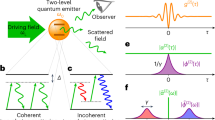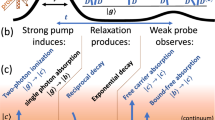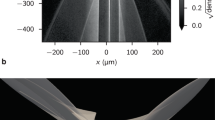Abstract
A single atom emitting single photons is a fundamental source of light. But the characteristics of this light depend strongly on the environment of the atom1,2. For example, if an atom is placed between two mirrors, both the total rate and the spectral composition of the spontaneous emission can be modified. Such effects have been observed using various systems: molecules deposited on mirrors3, dye molecules in an optical cavity4, an atom beam traversing a two-mirror optical resonator5,6,7,8, single atoms traversing a microwave cavity9,10,11 and a single trapped electron12. A related and equally fundamental phenomenon is the optical interaction between two atoms of the same kind when their separation is comparable to their emission wavelength. In this situation, light emitted by one atom may be reabsorbed by the other, leading to cooperative processes in the emission13,14. Here we observe these phenomena with high visibility by using one or two single atom(s), a collimating lens and a mirror, and by recording the individual photons scattered by the atom(s). Our experiments highlight the intimate connection between one-atom and two-atom effects, and allow their continuous observation using the same apparatus.
This is a preview of subscription content, access via your institution
Access options
Subscribe to this journal
Receive 51 print issues and online access
$199.00 per year
only $3.90 per issue
Buy this article
- Purchase on Springer Link
- Instant access to full article PDF
Prices may be subject to local taxes which are calculated during checkout




Similar content being viewed by others
References
Purcell, E. M. Spontaneous emission probabilities at radio frequencies. Phys. Rev. 69, 681 (1946).
Milonni, P. W. The Quantum Vacuum Ch. 6 (Academic, San Diego, 1994).
Drexhage, K. H. in Progress in Optics (ed. Wolf, E.) Vol. 12, 163–232 (North-Holland, Amsterdam, 1974).
DeMartini, F., Innocenti, G., Jacobovitz, G. R. & Mataloni, P. Anomalous spontaneous emission time in a microscopic optical cavity. Phys. Rev. Lett. 59, 2955–2958 (1987).
Jhe, W. et al. Suppression of spontaneous decay at optical frequencies: Test of vacuum-field anisotropy in confined space. Phys. Rev. Lett. 58, 666–669 (1987).
Heinzen, D. J., Childs, J. J., Thomas, J. F. & Feld, M. S. Enhanced and inhibited visible spontaneous emission by atoms in a confocal resonator. Phys. Rev. Lett. 58, 1320–1323 (1987).
Hood, C. J., Lynn, T. W., Doherty, A. C., Parkins, A. S. & Kimble, H. J. The atom-cavity microscope: Single atoms bound in orbit by single photons. Science 287, 1447–1453 (2000).
Pinkse, P. W. H., Fischer, T., Maunz, P. & Rempe, G. Trapping an atom with single photons. Nature 404, 365–368 (2000).
Goy, P., Raimond, J. M., Gross, M. & Haroche, S. Observation of cavity-enhanced single-atom spontaneous emission. Phys. Rev. Lett. 50, 1903–1906 (1983).
Hulet, R. G., Hilfer, E. S. & Kleppner, D. Inhibited spontaneous emission by a Rydberg atom. Phys. Rev. Lett. 55, 2137–2140 (1985).
Rempe, G., Walther, H. & Klein, N. Observation of quantum collapse and revival in a one-atom maser. Phys. Rev. Lett. 58, 353–356 (1987).
Gabrielse, G. & Dehmelt, H. G. Observation of inhibited spontaneous emission. Phys. Rev. Lett. 55, 67–70 (1985).
Dicke, R. H. Coherence in spontaneous radiation processes. Phys. Rev. 93, 99–110 (1954).
DeVoe, R. G. & Brewer, R. G. Observation of superradiant and subradiant spontaneous emission of two trapped ions. Phys. Rev. Lett. 76, 2049–2052 (1996).
Nagourney, W., Sandberg, J. & Dehmelt, H. Shelved optical electron amplifier: Observation of quantum jumps. Phys. Rev. Lett. 56, 2797–2799 (1986).
Sauter, Th., Neuhauser, W., Blatt, R. & Toschek, P. E. Observation of quantum jumps. Phys. Rev. Lett. 57, 1696–1698 (1986).
Bergquist, J. C., Hulet, R. G., Itano, W. M. & Wineland, D. J. Observation of quantum jumps in a single atom. Phys. Rev. Lett. 57, 1699–1702 (1986).
Diedrich, F. & Walther, H. Nonclassical radiation of a single stored ion. Phys. Rev. Lett. 58, 203–206 (1987).
Sackett, C. A. et al. Experimental entanglement of four particles. Nature 404, 256–259 (2000).
Moerner, W. E. in Atomic Physics 14 (eds Wineland, D. J., Wieman, C. E. & Smith, S. J.) AIP Conf. Proc. Vol. 323, 467–486 (AIP Press, New York, 1995).
Loudon, R. The Quantum Theory of Light (Oxford Univ. Press, Oxford, 1983).
Raab, C. et al. Diode laser spectrometer at 493 nm for single trapped Ba+ ions. Appl. Phys. B 67, 683–688 (1998); Appl. Phys. B 69, 253 (1999).
Raab, C. et al. Motional sidebands and direct measurement of the cooling rate in the resonance fluorescence of a single trapped ion. Phys. Rev. Lett. 85, 538–541 (2000).
Schubert, M., Siemers, I., Blatt, R., Neuhauser, W. & Toschek, P. E. Transient internal dynamics of a multilevel ion. Phys. Rev. A 52, 2994–3006 (1995).
Acknowledgements
We thank P. Zoller, D. Leibfried and G. Morigi for helpful discussions. We gratefully acknowledge support by the European Commission (TMR network QSTRUCT), by the Austrian Science Fund (FWF), and by the Institut für Quanteninformation GmbH.
Author information
Authors and Affiliations
Corresponding author
Rights and permissions
About this article
Cite this article
Eschner, J., Raab, C., Schmidt-Kaler, F. et al. Light interference from single atoms and their mirror images. Nature 413, 495–498 (2001). https://doi.org/10.1038/35097017
Received:
Accepted:
Issue Date:
DOI: https://doi.org/10.1038/35097017
This article is cited by
-
Hydrodynamic superradiance in wave-mediated cooperative tunneling
Communications Physics (2022)
-
Scalable collective Lamb shift of a 1D superconducting qubit array in front of a mirror
Scientific Reports (2019)
-
Superradiant emission from colour centres in diamond
Nature Physics (2018)
-
Fabrication of ultrahigh-precision hemispherical mirrors for quantum-optics applications
Scientific Reports (2018)
-
High-resolution adaptive imaging of a single atom
Nature Photonics (2016)
Comments
By submitting a comment you agree to abide by our Terms and Community Guidelines. If you find something abusive or that does not comply with our terms or guidelines please flag it as inappropriate.



